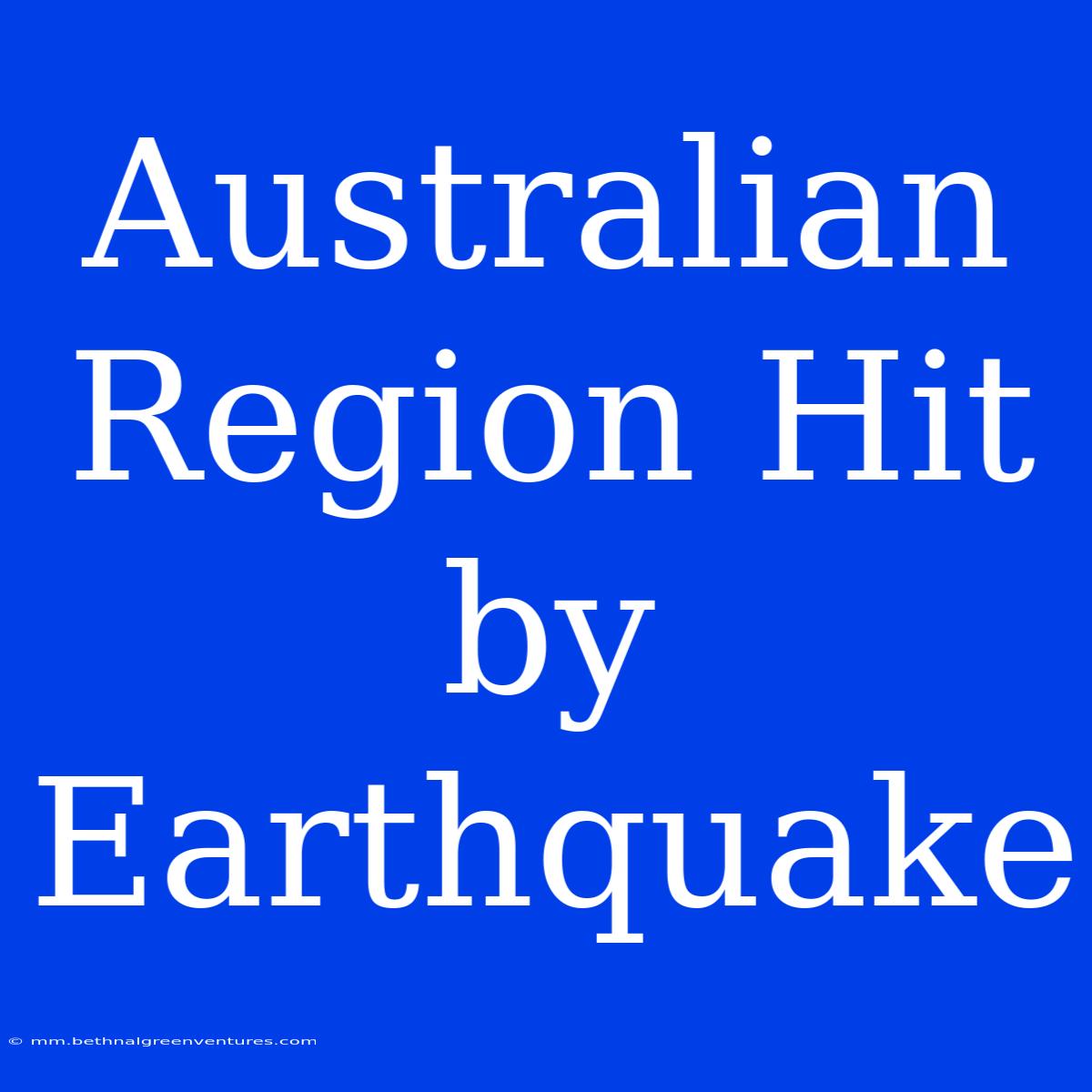Australian Region Rocked by Earthquake: A Look at Seismic Activity Down Under
Is Australia truly immune to earthquakes? While the perception is that Australia is earthquake-free, the reality is far more nuanced. Recent seismic activity in the Australian region serves as a stark reminder that the continent is not entirely immune to tremors. Understanding the geological factors and historical context of earthquakes in Australia is crucial for preparedness and awareness.
Editor Note: An earthquake recently struck the Australian region, highlighting the potential for seismic activity in the country.
Why this topic matters: Exploring seismic activity in Australia is crucial for several reasons. Firstly, it debunks the common misconception that Australia is earthquake-proof. Secondly, understanding the geological factors behind these events is vital for preparedness and mitigation strategies. Finally, studying these occurrences helps researchers refine our understanding of tectonic plate movement and its impact on the Australian continent.
Our Analysis: This article delves into the recent earthquake in the Australian region, examining its location, magnitude, and potential impact. We will also explore the geological context of earthquakes in Australia, considering historical events and the role of tectonic plates.
Key Takeaways:
| Key Takeaway | Description |
|---|---|
| Australia is not immune to earthquakes | While infrequent, Australia experiences earthquakes, particularly in specific regions. |
| Tectonic plate movement is a key factor | The Australian plate interacts with other plates, causing stress and potential for seismic activity. |
| Earthquake preparedness is important | Understanding risks and implementing mitigation strategies is crucial in earthquake-prone areas. |
Australian Earthquake Activity:
The recent earthquake serves as a reminder that Australia is not immune to seismic activity. Despite its perceived stability, the continent experiences occasional tremors, particularly in specific regions.
Geological Context:
Tectonic Plates: Australia sits on the Australian plate, which is constantly moving and interacting with other plates, including the Pacific, Eurasian, and Indo-Australian plates. These interactions can generate stress, leading to earthquakes.
Fault Lines: Several major fault lines traverse the Australian continent, including the Alpine Fault in Tasmania, the New England Fold Belt, and the Darling Fault in Western Australia. These fault lines are zones of weakness in the earth's crust, making them prone to seismic activity.
Historical Earthquakes: While Australia is not as earthquake-prone as other regions, historical records reveal significant earthquakes throughout its history. Notable events include the 1989 Newcastle earthquake, which registered 5.6 on the Richter scale, and the 2016 Tennant Creek earthquake, measuring 6.1.
Impact and Mitigation:
Impact: Earthquakes can cause damage to infrastructure, disrupt essential services, and potentially lead to injuries and casualties. The severity of the impact depends on the magnitude of the earthquake, the proximity to populated areas, and the vulnerability of buildings and infrastructure.
Mitigation: Strategies for mitigating earthquake risks include:
- Building Codes: Implementing strict building codes that incorporate earthquake-resistant design principles.
- Emergency Preparedness: Educating the public on earthquake safety measures, developing emergency plans, and conducting drills.
- Early Warning Systems: Implementing systems that detect and warn about impending earthquakes, providing valuable time for preparation.
Earthquake Preparedness in Australia:
The recent earthquake serves as a reminder of the importance of earthquake preparedness in Australia. While the risk may seem low, understanding the potential for seismic activity and implementing appropriate mitigation strategies can save lives and protect property.
FAQ:
Q: Are earthquakes common in Australia?
A: While not as frequent as in other regions, Australia experiences earthquakes, particularly in specific regions like the east coast and Northern Territory.
Q: What are the main causes of earthquakes in Australia?
**A: ** The movement and interaction of tectonic plates, particularly the Australian plate with its neighboring plates, are the primary causes.
Q: What is the risk of a major earthquake in Australia?
A: While the risk is lower than in other earthquake-prone areas, a significant earthquake is still possible, particularly in regions with active fault lines.
Q: What should I do if an earthquake occurs?
A: Drop, cover, and hold on. Seek shelter under a sturdy table or desk. Stay away from windows and heavy objects that could fall.
Q: Where can I find more information about earthquake preparedness?
A: Consult the Australian Government's Department of Home Affairs for official information on earthquake preparedness.
Tips for Earthquake Safety in Australia:
- Secure Heavy Objects: Secure heavy furniture and appliances to prevent them from falling during tremors.
- Develop a Family Plan: Create a family plan outlining evacuation routes and meeting points.
- Have a Go-Bag: Prepare a go-bag with essential supplies, including water, non-perishable food, a flashlight, and a first-aid kit.
- Learn First Aid: Enroll in a first-aid course to be prepared in case of injuries.
- Check Your Insurance: Review your home insurance to ensure adequate coverage for earthquake damage.
Summary:
The recent earthquake in the Australian region serves as a reminder that the continent is not immune to seismic activity. Understanding the geological factors behind earthquakes, incorporating earthquake-resistant design principles in building codes, and promoting public awareness are crucial for mitigating risks and ensuring safety.
Closing Message: While Australia may not be known for its frequent earthquakes, preparedness is still paramount. By understanding the potential for seismic activity, implementing effective mitigation strategies, and staying informed about earthquake safety measures, we can ensure the safety of our communities and minimize the impact of these natural events.
